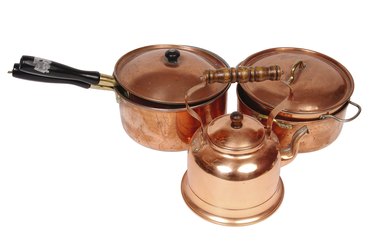Things You'll Need
Mild dish soap
Cotton cloth
Soft-bristled brush or plastic meshed scrub pad
Baking soda
Salt
Small bowl or cup
White vinegar or lemon juice
Flour
Ketchup

With brightly shining golden surfaces, it's little wonder that copper cookware remains a perennial favorite, but how it looks is secondary to the way it cooks. Copper pots and pans transfer heat quickly and evenly, allowing food to cook faster and more uniformly, without hot spots that lead to burnt-on food. You must care for copper cookware properly, however, especially the inside of tin-lined copper pots and pans. Shiny when new, unpolished, the copper outside discolors rapidly, undermining the efficiency of the material. Discoloration of the tin lining is unavoidable. Tin is soft, however, and wearing through or gouging the lining during cooking or cleaning can lead to unsafe cooking surfaces.
Cleaning the Tin
Step 1
Inspect the pan, paying close attention to the inside. Look for cracks, chips and worn areas or other degradation. This is important whether it's an old pan you just acquired or a newer pan that only you have used. Copper is a poisonous material and any hint of the tin lining being compromised or copper showing through should result in either relining the pan interior or throwing the pan away.
Video of the Day
Step 2
Soak the pan in warm, soapy water. Allow it to rest, soaking, for perhaps an hour -- some situations may require a shorter or longer duration. Use the least amount of soak time possible.
Step 3
Scrub away loosened food deposits and contaminants such as hard water deposits, using a cotton cloth, soft-bristled brush or plastic meshed scrub pad at most. Use circular motions and a light, gentle pressure to coax the deposits away.
Step 4
Remove persistent deposits by filling the pan with water and adding baking soda at a rate of 2 tbsp. baking soda to 1 cup water. Boil the solution for five minutes then turn off your stove burner and soak an hour or two. Scrub again, using a cloth, soft brush or plastic scouring pad. Using the baking soda helps lighten a discolored tin surface and the heat helps loosen deposits.
Cleaning the Copper
Step 1

Place about 2 tbsp. of coarsely ground salt in a small bowl or cup. Pour in 1/4 cup white vinegar, a little at a time, and blend well to spread the salt through the vinegar evenly. Substitute lemon juice for the vinegar as an alternative.
Step 2
Add enough flour to the salt and vinegar or lemon solution to create a paste, like shoe polish or car wax. Stir well to blend evenly.
Step 3
Dip the tip of a soft cotton cloth in the paste. Use the cloth to polish the copper exterior, working in circular strokes to avoid scratches. Press lightly but firmly and cover the entire outside surface.
Step 4
Rinse the paste off the pan exterior thoroughly. Buff dry to encourage a shiny glow.
Step 5
Cover the pan's exterior surface with ketchup if stains and discoloration persists. Rub the ketchup in and around the brass, using a soft cotton cloth. Rinse and dry with a buffing motion. The tomatoes in ketchup are acidic, which helps the copper to come clean.
Tip
A section of lemon, sprinkled with salt or sugar, can also be used on the copper exterior to clean and shine.
Only use plastic or wood utensils with tin-lined copper pans to avoid unnecessary damage to the soft, thin tin lining.
Do not overheat the pan or heat it without anything in it. Tin softens at 450 degrees Fahrenheit and melts at 460.
Use commercial copper cleaners, if preferred, on the outside only. Never use abrasive cleaners on either the outside or inside of the pan.
Do not put your copper pans in the dishwasher. Doing so will degrade the copper exterior.
Copper reacts with the air to oxidize, which leads to color changes and darkened areas. Polish regularly to avoid this problem.
Warning
Never cook in a pan where the copper shows through. While used in small amounts by the body, exposing foods to copper -- especially acidic foods -- introduces uncontrolled amounts of copper to the body. The human body does not process and excrete copper well, and over time, the copper can build up, leading to toxicity. Symptoms include vomiting, nausea, stomach pain and diarrhea at low levels, and stomach or intestinal ulcers, jaundice and liver or kidney damage at high levels.
Video of the Day
- Atlantic Retinning and Metal Refinishing; Care For Your Copper Cookware; Cecile Lamalle, et al.
- Only-Cookware.com: How to Clean Copper Cookware
- Kitchen Savvy; Care of Copper Pots; November 2007
- The Copper Shop; Copper Cookware; October 2007
- Chefs: Copper Cookware, Saucepan
- The Purple House; Oliver Sharp's cookware FAQ; Oliver Sharp
- Divertimenti: Copper Buying Guide
- Buy Copper Cookware.com: Mauviel FAQ's
- Cooking With Friends: Copper Pots